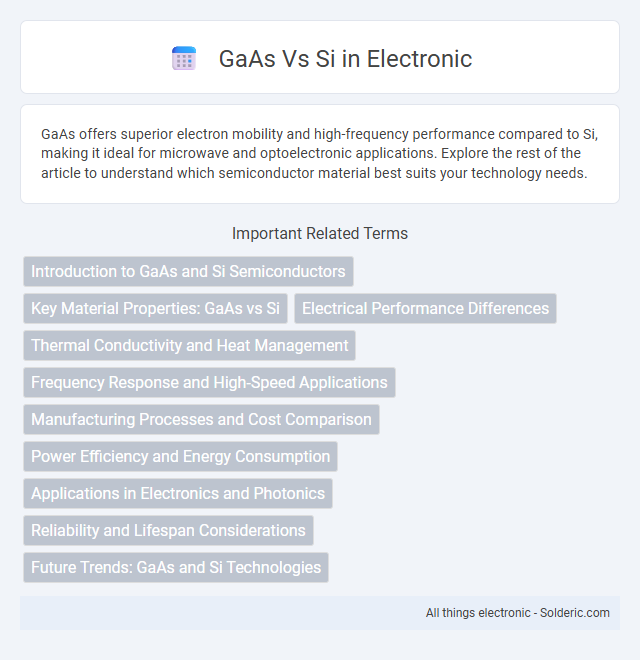GaAs offers superior electron mobility and high-frequency performance compared to Si, making it ideal for microwave and optoelectronic applications. Explore the rest of the article to understand which semiconductor material best suits your technology needs.
Comparison Table
| Feature | Gallium Arsenide (GaAs) | Silicon (Si) |
|---|---|---|
| Material Type | Compound Semiconductor | Elemental Semiconductor |
| Electron Mobility | ~8500 cm2/V*s (high) | ~1400 cm2/V*s (moderate) |
| Thermal Conductivity | 46 W/m*K | 150 W/m*K (higher) |
| Bandgap | 1.42 eV (direct) | 1.12 eV (indirect) |
| Operating Frequency | Up to THz (high-frequency) | Up to GHz (moderate-frequency) |
| Cost | Higher (expensive substrates) | Lower (abundant and cheap) |
| Application | High-speed RF, optoelectronics, LEDs, solar cells | Microprocessors, memory, integrated circuits |
| Manufacturing | Complex, lower yield | Mature, high yield |
Introduction to GaAs and Si Semiconductors
Gallium Arsenide (GaAs) and Silicon (Si) are two fundamental semiconductor materials with distinct electrical and physical properties critical for electronic device performance. GaAs offers higher electron mobility and direct bandgap, making it ideal for high-frequency and optoelectronic applications, while Si provides excellent thermal conductivity and cost-effectiveness vital for large-scale integration in microelectronics. Understanding the characteristics of GaAs and Si semiconductors helps optimize your choice of materials for specific technological applications.
Key Material Properties: GaAs vs Si
Gallium Arsenide (GaAs) exhibits higher electron mobility and a direct bandgap of 1.42 eV, enabling faster electronic speeds and efficient optoelectronic applications compared to Silicon's (Si) indirect bandgap of 1.12 eV and moderate electron mobility. GaAs has superior thermal stability and radiation resistance, essential for high-frequency and space applications, whereas Si provides lower cost, excellent mechanical strength, and a mature fabrication infrastructure. Your choice between GaAs and Si depends on prioritizing performance in high-speed or optical devices versus cost-efficiency and widespread compatibility in conventional electronics.
Electrical Performance Differences
Gallium Arsenide (GaAs) exhibits significantly higher electron mobility compared to Silicon (Si), enabling faster switching speeds and greater frequency performance in high-speed electronic devices. GaAs's superior electron velocity reduces power consumption and enhances signal amplification, making it ideal for RF and microwave applications. Your choice between GaAs and Si impacts device efficiency, with GaAs offering better electrical performance in high-frequency, high-speed environments.
Thermal Conductivity and Heat Management
Gallium arsenide (GaAs) exhibits lower thermal conductivity, approximately 46 W/m*K, compared to silicon's (Si) thermal conductivity of around 150 W/m*K, making heat dissipation more challenging in GaAs-based devices. Efficient heat management strategies, such as advanced thermal interface materials and optimized heat sinks, are essential for GaAs to prevent overheating and ensure device reliability. The superior thermal conductivity of silicon enables better heat spreading, supporting higher power applications with simpler cooling solutions.
Frequency Response and High-Speed Applications
Gallium Arsenide (GaAs) outperforms Silicon (Si) in high-frequency response due to its higher electron mobility, enabling faster signal processing and lower noise in microwave and millimeter-wave applications. GaAs devices operate effectively at frequencies exceeding 100 GHz, making them ideal for high-speed communication systems, radar, and satellite technology. Silicon, while more prevalent and cost-effective, typically exhibits lower cutoff frequencies around 50 GHz, limiting its use in ultra-high-speed integrated circuits.
Manufacturing Processes and Cost Comparison
Gallium Arsenide (GaAs) manufacturing involves complex epitaxial growth techniques like Molecular Beam Epitaxy (MBE) or Metal-Organic Chemical Vapor Deposition (MOCVD), resulting in higher production costs compared to silicon (Si) wafers, which rely on well-established and cost-efficient Czochralski crystal growth methods. The limited availability of GaAs substrates and lower wafer sizes contribute to its premium pricing, while silicon benefits from mature, high-volume manufacturing infrastructure and abundant raw materials. Consequently, silicon remains more economical for large-scale semiconductor production despite GaAs offering superior electron mobility and frequency performance in specialized applications.
Power Efficiency and Energy Consumption
Gallium Arsenide (GaAs) transistors exhibit superior power efficiency compared to Silicon (Si) due to their higher electron mobility, enabling faster switching speeds with lower power losses in high-frequency applications. GaAs devices typically consume less energy under equivalent operating conditions, making them ideal for RF amplifiers and microwave circuits where energy efficiency is critical. Silicon, while more prevalent and cost-effective, tends to have higher energy consumption in high-speed and high-frequency scenarios due to its lower carrier mobility.
Applications in Electronics and Photonics
Gallium Arsenide (GaAs) excels in high-frequency electronics and photonics due to its superior electron mobility and direct bandgap, making it ideal for RF amplifiers, microwave devices, and optoelectronic components like LEDs and laser diodes. Silicon (Si) remains dominant in digital electronics and power devices because of its abundant availability, well-established fabrication processes, and excellent thermal conductivity. Your choice between GaAs and Si depends on whether the application prioritizes speed, frequency, and photonic integration or cost-efficiency and large-scale integration.
Reliability and Lifespan Considerations
Gallium arsenide (GaAs) devices typically exhibit superior reliability in high-frequency and high-temperature environments compared to silicon (Si), due to GaAs's higher thermal stability and resistance to radiation-induced damage. Silicon, however, benefits from mature fabrication processes and robust oxide layers that enhance device longevity in standard applications, making it a dependable choice for general-purpose electronics. Your selection should consider these reliability and lifespan factors in relation to the intended operating conditions and performance requirements.
Future Trends: GaAs and Si Technologies
GaAs technology is advancing with improvements in high-frequency and high-power applications, driven by 5G, satellite communications, and radar systems, where its superior electron mobility and thermal performance outpace Si. Silicon remains dominant due to its scalability, cost-effectiveness, and integration capabilities, especially benefiting from ongoing innovations in Si photonics and AI accelerators. Future trends indicate a growing hybrid approach leveraging GaAs for RF front-ends and Si for digital processing, optimizing performance and manufacturing efficiency in emerging semiconductor markets.
GaAs vs Si Infographic

 solderic.com
solderic.com